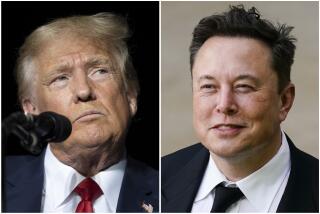Clinton Holds Historic Online Chat
- Share via
WASHINGTON — There’s no need to store food if you plan to be in the United States when the new millennium dawns.
The chances of a peace agreement between Israel and the Palestinians are good--”better than 50-50.”
And future world leaders will have to deal with “miniaturized” weapons of mass destruction that do not rely on missiles as the delivery mechanism.
Expressing his views on a wide range of topics, Bill Clinton on Monday night became the first president to participate in a fully interactive online chat session. About 50,000 Internet users logged on from around the world to see and hear his remarks.
And for more than 90 minutes, the man who openly confesses to being “technologically challenged” chatted up a storm, appearing at once to be fascinated and bemused by a technology that he has fostered through his policies but does not personally embrace.
Indeed, Clinton repeatedly referred to the historic session as simply a “press conference,” and it was easy to see why.
All he had to do was sit on the stage--before cameras, of course--and answer questions that came in over the transom, screened and posed by a moderator.
Someone else typed his answers.
The event was hosted by the Democratic Leadership Council, a centrist organization that Clinton once chaired, and by Excite@Home, a global media and technology company based in Redwood City, Calif.
The president was joined by five Democratic officials from their home bases around the country, including Maryland Lt. Gov. Kathleen Kennedy Townsend and San Jose Mayor Ron Gonzales, although a glitch prevented Gonzales from being seen or heard until almost an hour into the session.
The other Democrats who participated in the session were New Hampshire Gov. Jeanne Shaheen, Wisconsin state Sen. Antonio Riley and Bethlehem, Pa., Mayor Don Cunningham.
Clinton likened the virtual town hall meeting to Franklin D. Roosevelt’s fireside chats and John F. Kennedy’s live-TV news conferences, praising the use of “the most modern technology for . . . old-fashioned communication between the American people and their president.”
Clinton also took note of the astounding speed with which the Internet has developed, pointing out that when he took office, only 1.3 million computers were connected to the Internet--compared to more than 56 million now.
He also said that the number of Web sites has reached 3.6 million, from only 130 in 1993.
The wide-ranging questions afforded Clinton the opportunity to tout his agenda, from gun control and Medicare prescription drug coverage to the hiring of 100,000 new teachers to reduce class sizes and the extending of health insurance coverage.
To one questioner, the president stated that Congress should enact “modest tax relief” even though he has vetoed a nearly $800-billion tax cut.
“And I will be flexible in working with Congress on what the contents should be,” he vowed.
When “Cynthia in Arizona” asked whether Clinton planned to have a food stash on hand because of problems that may rise from the Y2K computer bug, the president replied: “The answer is no,” adding that only “some of our small businesses” appear not to be prepared for the change.
Questions came from Canada and England as well as from throughout the United States.
One questioner asked Clinton about his post-White House plans, another about what Clinton believes will be his legacy. There was no mention of Clinton’s impeachment.
The president said that he intends to work on his library and create a public policy center, both in Little Rock, Ark.
Of his legacy, Clinton said he would like to be remembered as having presided over an era of “restoration of prosperity and hope.”
The session seemed to give Clinton energy. He stayed on 20 minutes longer than planned.
After nearly seven years in office, he said as the session wrapped up: “I understand how a president can get out of touch. . . . This is very, very helpful.”
More to Read
Get the L.A. Times Politics newsletter
Deeply reported insights into legislation, politics and policy from Sacramento, Washington and beyond. In your inbox twice per week.
You may occasionally receive promotional content from the Los Angeles Times.










